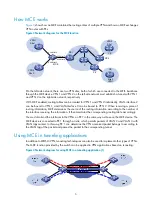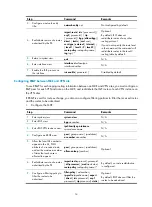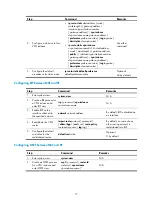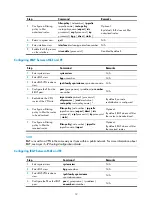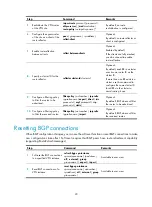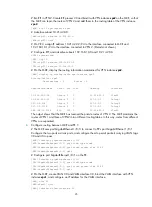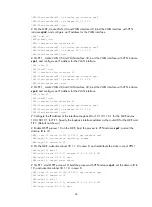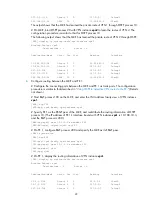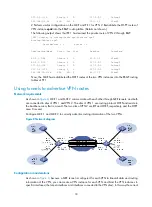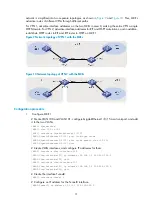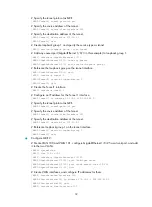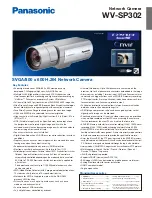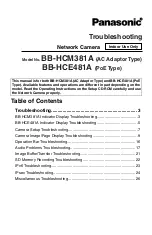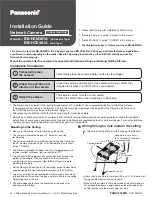
18
Step Command
Remarks
3.
Disable routing loop
detection.
vpn-instance-capability simple
Disabled by default.
You must disable routing loop
detection for a VPN OSPF process on
the MCE. Otherwise, the MCE
cannot receive OSPF routes from the
PE.
4.
Configure the OSPF
domain ID.
domain-id
domain-id
[
secondary
]
Optional.
0 by default.
5.
Redistribute the VPN
routes.
import-route
protocol
[
process-id
|
allow-ibgp
] [
cost
cost
|
type
type
|
tag
tag
|
route-policy
route-policy-name
] *
By default, no route of any other
routing protocol is redistributed into
OSPF.
6.
Configure a filtering policy
to filter advertised routes.
filter-policy
{
acl-number
|
ip-prefix
ip-prefix-name
}
export
[
protocol
[
process-id
] ]
Optional.
By default, advertised routes are not
filtered.
7.
Configure the default
parameters for
redistributed routes (cost,
route number, tag, and
type).
default
{
cost
cost
|
limit
limit
|
tag
tag
|
type
type
} *
Optional.
The default cost is 1, the default
maximum number of routes
redistributed per time is 1000, the
default tag is 1, and default type of
redistributed routes is Type-2.
8.
Create an OSPF area and
enter OSPF area view.
area
area-id
By default, no OSPF area is created.
9.
Enable OSPF on the
interface attached to the
specified network in the
area.
network
ip-address wildcard-mask
By default, an interface neither
belongs to any area nor runs OSPF.
Configuring IS-IS between MCE and PE
Step Command
Remarks
1.
Enter system view.
system-view
N/A
2.
Create an IS-IS process
for a VPN instance and
enter IS-IS view.
isis
[
process-id
]
vpn-instance
vpn-instance-name
N/A
3.
Configure a network
entity title.
network-entity
net
Not configured by default.
4.
Redistribute the VPN
routes.
import-route
{
isis
[
process-id
]
|
ospf
[
process-id
] |
rip
[
process-id
]
|
bgp
[
allow-ibgp
] |
direct
|
static
} [
cost
cost
|
cost-type
{
external
|
internal
} |
[
level-1
|
level-1-2
|
level-2
] |
route-policy
route-policy-name
|
tag
tag
] *
Optional.
By default, IS-IS does not
redistribute routes of any other
routing protocol.
If you do not specify the route level
in the command, the command will
redistribute routes to the level-2
routing table by default.


